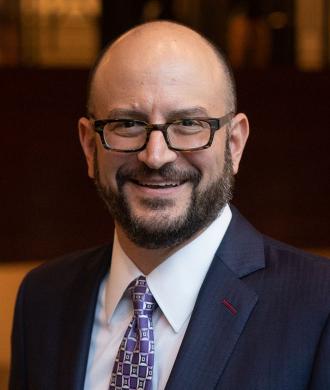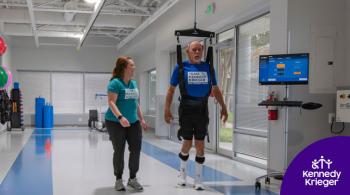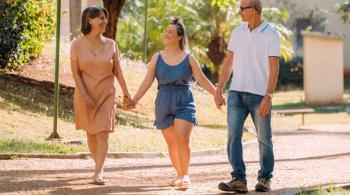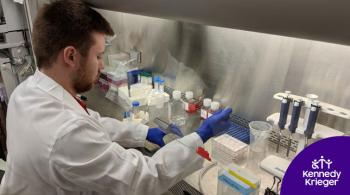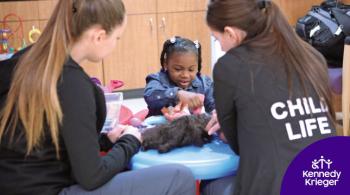Pediatric Clinical Research
On this episode of Your Child’s Brain, Dr. Bradley Schlaggar, president and CEO of Kennedy Krieger Institute, welcomes Dr. Amy Bastian, chief science officer and director of the Center for Movement Studies at Kennedy Krieger to discuss pediatric clinical research as a way forward to better care and to developing treatments for childhood disorders and injuries.
Resources
Learn More About Our Featured Speakers
Learn More About Our Featured Speakers
View Episode Transcription
Dr. Brad Schlaggar (BS): Welcome to Your Child's Brain, a podcast series produced by Kennedy Krieger Institute with assistance from WYPR. I'm Dr. Brad Schlaggar, pediatric neurologist and president and CEO of Kennedy Krieger Institute. Pediatric clinical research is a critically important way forward to improving patient care and to developing effective, rational treatments for diseases and illnesses, both rare and common, impacting children. Participation in research and clinical trials plays an essential role in discovering better and more innovative ways to deliver care that improves outcomes. Over the past 40-plus years we've seen a number of remarkable accomplishments in pediatric care that have come about due to pediatric research, including the prevention of infectious diseases with vaccines that have saved literally millions of lives, genetic-based therapies for rare neurologic diseases in children like spinal muscular atrophy and adrenoleukodystrophy. We've reduced dramatically sudden infant death by putting neonates and infants on their backs to sleep. We've developed chemotherapeutic and or recently precision interventions for some childhood cancers dramatically improving survivorship and have improved survivorship and life expectancy for children with genetic diseases like cystic fibrosis and sickle cell. All that said, we still have a lot of work in front of us to improve outcomes from pediatric onset illness. Research will continue to be the key to making progress. Today, we're going to talk more about pediatric research with my colleague and friend, Dr. Amy Bastian. Dr. Bastian, a physical therapist and internationally known neuroscientist, is the chief science officer at Kennedy Krieger Institute, where she also directs the Center for Movement studies. Dr. Bastian is a professor of neuroscience and neurology at the Johns Hopkins University School of Medicine. Welcome Amy. Amy as I mentioned, you are the chief science officer at Kennedy Krieger and before we talk about that role, because you have such an interesting background as a clinician and a neuroscientist, could you talk about your path, your training and how that pathway led to the creation of the Center for Movement Studies?
Dr. Amy Bastian (AB): It's a path that really started for me when I was a child. I loved movement and loved to play sports. I absolutely felt comfortable doing all kinds of crazy things, much to the chagrin of my parents. When I got to college, I decided I wanted to do something where I could be involved in movement and I ended up going to physical therapy school because it seemed a really ideal fit. What was interesting though is once I finished physical therapy school and started working at a hospital that took care of people with neurological diseases, I realized that I didn't understand why, how, when I should be doing certain things with certain patients and I was fascinated by it so I decided that I needed more education. I went back to graduate school and decided that I would blend my interests in the brain and my interest in movement control.
BS: Well, how does that background, that pathway that you just described, how does it influence how you go about studying how the brain learns both typically and after a disease or injury?
AB: What really drives our ability to have this rich repertoire of movements is learning in childhood and understanding the mechanics of movement and understanding the efficiencies of movement allow me to think about, allow our team to think about how the nervous system is developing to make movement control of the best it can be. It also helps us to understand that there are critical times to be learning movement important times I should say. There are also challenges if you're not moving enough and in the right ways and so I think knowing something about the mechanics and understanding what the brain might want to optimize is a good blend of the two things.
BS: You take advantage of virtual reality as a technology and a lot of ways and either way, I think you're really an engineer in many ways, the way you approach problems, before we get to the chief science officer part of the discussion, just maybe say a few more words about how engineering, how virtual reality as a technology, how they play a role in your approach to studying the brain.
AB: When I talk to people about my lab, usually people think about a wet lab, test tubes, specimens, cells, cell culture. You go into my lab and you don't see any of those things, what you see are robots, crazy treadmills with belts that can move independently under each foot. The reason that we have these kinds of technologies is because it allows me to study how people learn to control the body under these novel circumstances and then we can start to see how those motor memories are formed, how they solidify, how you bring them back up and how they're affected by damage to different parts of the nervous system.
BS: Let's talk about your role as chief scientist at Kennedy Krieger, what does that rolemean for you?
AB: Being the chief science officer has been such a wonderful educational experience and honor, because I get to learn about all of the science that is going on at Kennedy Krieger, I would say that the chief scientist role really allows me to connect with all the physicians and scientists and clinicians and staff in order to understand where they're going with their research and how we can help them to thrive.
BS: It's often expressed that it's going to be a pill or a gene therapy or something at that level that's going to cure a disease or bring somebody who's got atypical development into typical development. But we know, and I think one of the reasons why it's so important that a systems and cognitive neuroscientists like yourself is at the helm as a chief science officer for the Institute is because it's going to require both molecular and pharmacologic therapies, but also it's going to require learning, mechanisms of learning or re-learning to get an individual back on a more typical developmental trajectory. How do you think about that interplay between the different mechanisms for intervention for improving outcomes?
AB: I think that you said it beautifully and let me give you an example of this. Early in life, of course, the nervous system is not mature. If you have a disorder that involves a component of the nervous system, correcting it is one thing. Maybe you get the right neurotransmitter or maybe you are expressing the right gene. That in and of itself will help but, what it won't do is it won't do what we naturally need to be able to do in order to develop and that is, we have to be able to experience the right intensity variety of experiences in order to make sure that we're forming the right connections in the brain. As a very young child, everything you do, you move, you see, you listen, you think, you feel, those are forming the circuits that you will use in order to begin to do the things that children do. I think that this interplay is so critical and that a pill or a gene is an essential part, but not the only part. If you don't have the right experiences and you don't have the right therapies and you don't have the right processes laid down in the brain, you're not going to have an optimal outcome at all.
BS: How crucial then is the research enterprise for finding effective interventions for children with neurodevelopmental issues and where do you think are the most exciting and promising research directions therefore?
AB: I think we all believe now that there's a lot of promising gene therapy. Gene therapy has already shown amazing advances in terms of treating very lethal diseases in children. I think that manipulating that fundamental part of the nervous system is going to allow us to make even better gains using our conventional or developing therapies, for example. I'm really particularly excited about combination therapies. I'm excited about not just using a new drug, but also using new techniques to drive plasticity or learning in the nervous system and to help children learn to speak, to walk, to think, and to have good emotional function. Another advance that's really critical is simply our ability to measure and understand activity in the nervous system and the behavior of the children that we're seeing. By measuring things, we're going to have better chances of understanding outcomes and being able to predict who is responsive to therapies, drugs, gene therapies, etc. This precision approach where if we can measure a variety of hard to quantify factors and then make good predictive models then I think some of these other tools can be deployed in a much more specific way.
BS: Yes. I share your excitement about the opportunities in front of us because of improved ability to make measurements that will make it possible to apply more precision approaches to truly individualized therapies. So much of the work that's done is looking at the population level response to an intervention and really what you care about, what we all care about as clinicians, as parents, for example, is making sure that the intervention is really specific for your child or the patient in front of you. Tell me the work that you're doing in your own laboratory on typical development of motor function.
AB: Understanding typical development is absolutely essential to understanding how we would want to design an intervention for somebody who has cerebral palsy. A younger child with cerebral palsy may actually not have all of the learning mechanisms that we think are important for movement control online yet, but not because they have cerebral palsy, because they're young. And an older child may have more mechanisms online. We don't know what to expect and so if we know, for example, that we cannot give a child a particular therapeutic treatment delivered in a way that uses reinforcement learning or a specific type of sensory feedback because that child doesn't have the capacity yet to use that information because they're too young. What we can glean from this is that we will know what is available for a child to take advantage of in the nervous system and we'll also know if it's not there, that means that something about their disorder has affected that circuit and it's going to affect their ability to learn in that manner.
BS: Some people might ask, is it even necessary at this point to have research involving children, including typically developing children? Why can't we just extrapolate from studies that involve adults to apply that information to children?
AB: We all know intuitively that children are not little adults, but it's a much bigger issue than just that. The brain and the body are developing and how children are using the systems in the brain to be able to create the behaviors they want relies on many mechanisms that are coming online during childhood. Something that may be available for an adult may not be available at all for a child. So a child may not be able to learn using certain kinds of interventions. They also may not have the same neural architecture that allows them to take advantage of things that we see in adults. A reason that we have to study, typically developing children and why this is so important is, we absolutely need to understand how these behaviors emerge in childhood, how the capacity of the brain changes in childhood, how the circuits are formed and re-formed through learning and experience and ultimately, how we can best dissect what's the problem with development, what's the problem with pathology and what is typical. I have to encourage everybody to embrace that. We really, really need these studies of typically developing children.
BS: Hundred percent agree. Let's turn our attention to some basic elements of the research process. What happens in a research study that involves humans? What's a clinical trial and how does the clinical trial differ from other kinds of research?
AB: Let's start with research that involves human subjects. Research that involves human subjects is very carefully governed by regulatory bodies. When you enroll in a human subjects study, there will be an institutional review board that understands everything that is going to be done in this study, it's explained to you, you are told about the risks and the benefits, you're told about the duration of the study and what it entails for you to do. For example, in one of my studies, you may come in and I will tell you that you're going to be making reaching movements in virtual reality with a robot. You're going to see some targets and you're going to play some games and you're going to feel some forces, and we're going to be making a lot of measurements. That's a very simple study. Another study may involve you lying in the MRI scanner and scanning your brain so we can understand the structure of your brain. Those are standard human subjects studies that we often do in our fields of work. A clinical trial is a study that is designed to understand if an intervention of some kind is safe and effective, and to understand things like dosing, how much of a medication or therapy or any other intervention, behavioral intervention is needed to have a good effect. It also may help us to understand who will benefit and who won't. The beauty of clinical trials I have to say is that they're so heavily scrutinized in a good way, [LAUGHTER] that we know and spend so much time looking at safety profiles, working with government agencies to make sure that we're meeting all the right requirements to make our science as safe as possible. Honestly, it allows people to get care that isn't necessarily available yet. There are like five times more clinical trials for adults than children. Children are arguably more complex because their nervous systems are developing and changing and they're growing, and so we really need more of that, and it's done in a safe and rigorous way and in an informed way. It's just absolutely necessary.
BS: There really is a significant disparity between research studies, clinical trials inclusive for children versus adults. It also reflects differences in funding. Probably also has a lot to do with a sense of the process of enrollment and consenting one's own child. For a parent considering consenting their child for research participation, how does that parent go about weighing the benefits and risks of that participation?
AB: It's an important component for the investigator who's running this study to have a very clear and thorough description of risks, benefits, and other considerations like is this going to take a lot of time? [LAUGHTER] Is this going to be something that you can actually do in your life if you need to have your child training for an hour a day for six months. I think those are the kinds of considerations that a parent will need to make. I think that the good news is that regulatory bodies are very cautious about studies that impose anything more than minimal risk with children. Our studies with children have to have some benefit in order to have any risk, and the risk benefit profile is scrutinized. I think that a parent is going to want to come in and first of all, understand why they're doing the research. Understand what the risks are, and sometimes there is benign as boredom, [LAUGHTER] hence sometimes they're maybe getting a little blood drawn, which is not terribly risky. The child may not enjoy it, but they're not risky. It also the benefits then, of course, are important to weigh whether this is a study that will help the parent to understand a disorder that the child has, or it may even be something that could be therapeutic for the child. Those things all have to be weighed in considering.
BS: You touched on this a bit, but what are some of those built-in mechanisms that are in place to protect privacy, confidentiality, and to make sure that the data belonging to that child research participant, it stays protected?
AB: Just like your medical records at any of your medical providers, the research is also governed such that researchers cannot share protected health information or any identifying information. Everything that is collected is de-identified before we make publications and before we disseminate information.
BS: We talked about some of the challenges that have to do with funding and even availability of studies in children. But one of the big challenges, once there are studies in place and funding available is recruitment. What are the challenges that you know in recruiting children to participate in research studies?
AB: Recruitment is a huge issue. It's so important. Recruitment is challenging for many reasons. It's not just one person you have to bring in. It's a parent, it's a child, it might be their brothers and sisters. It takes time away from school potentially, or it takes time away from family. It's often something that a parent isn't even aware of, and so it's recruiting. Getting the message out to parents is sometimes challenging. It's not something that we can just disseminate always on social media or any other outlet. It requires a lot of careful work.
BS: How can parents learn more about what research studies and what clinical trials are available for participation?
AB: The first place I would go if you're interested in a clinical trial is ClinicalTrials.gov. That's a website and it's searchable and it'll tell you which trials are enrolling, that is, they're taking new participants. It'll tell you about the trial, where it is, what conditions there might be clinical trials to treat, and so forth. Most major medical institutions also have websites that post the need for different kinds of participants. Healthy participants, typically developing children and people with different disorders. Those are two major places to go. There are other research recruitment websites, but I would start there.
BS: On the podcast webpage, we can post links to ClinicalTrials.gov and other resources that you think are good and reliable for directing people, not only to available studies, but perhaps to information about the whole process to help demystify the experience and make people feel more comfortable about the entire process. Because as we've been discussing, it's really critically important that we have not only the research in place, but also the participation in it, so that work can lead to improved outcomes for the children for whom we care. Let's close with you sharing what you consider to be the most exciting directions for you and your own research team at Kennedy Krieger.
AB: Right now, we are actually trying to map out the developmental time course of maturation of motor learning mechanisms. How the brain uses information to learn and control movements ranging from sitting to walking to reaching, and build on those kinds of innate things that you're born with in order to make your body do what you want it to do. Honestly, we're finding things are maturing much later than we thought. This is a large study. We're recruiting lots of typically developing kids. It will really help the children that have damage to the nervous system. Because now we'll know what the baseline is and we'll understand how it's changing. That's something I'm really focused on right now. It's without that information, we will not know what to expect and how to intervene when people have damage to the nervous system during development, we have to know what typical development is, and we have to have a really granular, fine measurement of those things.
BS: This kind of work is so critically important for understanding a typical development of the motor system, and so much of what we take care of in neurodevelopmental disorders, for example, involves the motor system. It's work that's key to really, it's part of the fabric of all that we do in terms of interventions to improve outcomes, so thank you. Thank you to our guest, Dr. Amy Bastian, for a fascinating discussion. We hope you have found this information interesting and helpful. Please consider sharing this podcast with friends and rating it. You can check out our entire library of topics on Your Child's Brain at Wypr.org, KennedyKrieger.org, Wypr.org/studios or wherever you get your podcasts. You've been listening to Your Child's Brain. Your Child's Brain is produced by Kennedy Krieger Institute with assistance from WYPR and producer Spencer Bryant. Please join us next time as we examine the mysteries of Your Child's Brain.

